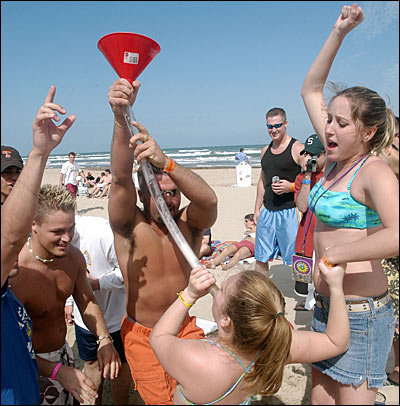Heavy drinking among college students
Heavy drinking and binge drinking are major problems on many college campuses in the 21st century, and these problems continue unresolved despite efforts to stem the tide of alcohol abuse. (Note that most binge drinkers are not alcoholics, although binge drinking can have many serious health consequences.) In one study by J. R. Knight and colleagues, the researchers found that of 14,000 students who were surveyed, 31 percent met the criteria for alcohol abuse, and also 6 percent met the criteria for alcohol dependence.
A study by Carlos Blanco et al., published in 2008 in the Archives of General Psychiatry, demonstrated that college students had a greater risk for developing a problem with alcohol abuse and alcohol dependence than did their noncollege peers. For example, of the 2,188 college students surveyed, about 8 percent had a problem with alcohol abuse, and even more disturbingly, about 13 percent of the students were alcoholics. In contrast, about 7 percent of 2,904 noncollege students of the same age had a problem with alcohol abuse and 10 percent were alcoholics.
Clearly, alcohol is a problem for both groups, although apparently a greater problem among college students. Other studies have confirmed that many college students have a serious problem with heavy drinking, including binge drinking.
Drinking has become an ingrained part of the culture of many college campuses. Some college students also engage in the practice of binge drinking and even excessive drinking to the point of suffering from alcohol poisoning, a condition in which the liver cannot process alcohol as fast as it is consumed. Alcohol poisoning can cause death.
Some college students engage in extreme binge drinking, or drinking 10 or more drinks in a row on one occasion in the past two weeks. According to the Monitoring the Future results for 2007, 26 percent of college males and 6 percent of college females engaged in this behavior in 2005–07. In ddition, 12 percent of college males and less than 1 percent (0.8 percent) of college females downed 15 or more drinks in a row on one occasion. College men are also more likely to engage in daily drinking than women in college; the Monitoring the Future survey found that 6.2 percent of college men drank every day in 2007, compared to 3.1 percent of college women.
 The Monitoring the Future study researchers also noted that throughout the 28 years that college students have been surveyed, they have consistently reported episodes of binge drinking.
The Monitoring the Future study researchers also noted that throughout the 28 years that college students have been surveyed, they have consistently reported episodes of binge drinking.
Say the researchers, “It is interesting to conjecture why college students did not show much decline in heavy drinking for a decade (1981–1991) while their noncollege peers and 12th graders did. One possibility is that campuses provided some insulation from the effects of changes in the drinking age laws that took place during that interval.”
Similarly, entrenched on many college campuses is a culture of binge drinking which has proven impervious to many social trends (and intervention attempts) regarding excessive alcohol use. It is also true that some college students are of the legal drinking age while others are not, while in high school, it is illegal for all students to consume alcohol. This can make enforcement of the laws confusing and difficult, especially since many underage drinkers carry false IDs that purportedly “prove” that they are 21 or older.